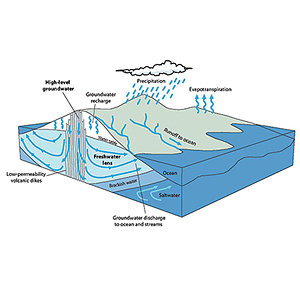
|
| Recharge on islands surrounded by saltwater ends up deposited in a lens or “bowl” below the surface. Source: USGS |
Over the years, much of my drilling has taken me to isolated islands around the world. This requires rethinking how the groundwater lays underground. Most waters are deposited by rainfall. As the water falls from the clouds it is deposited in lakes, streams and rivers, and eventually soaks into the earth where it is stored in the underground aquifers.
Islands are similar. However, on many islands the water is deposited in what we call a lens or bowl. This means that the water soaks into the ground and is stored in an imaginary bowl. Imagine the outer perimeter of the bowl being a separator of sea water and fresh water. Since saltwater is heavier than fresh water, the rain water penetrates the earth and is deposited in the bowl.
I first experienced this in Saint Martin, Nevis, St. Kitts, Antigua and other islands around the FWI (French West Indies). On these islands you may encounter some perched water and springs, but they only supply water seasonally. However, most of the groundwater is stored in the bowl effect.
Most recently my youngest son “Piglet” was drilling wells on La Gonave Island near Haiti. La Gonave Island is formed mostly from limestone. Some of the limestone is very porous with holes in the limestone the size of baseballs and larger. Other parts of the island contain a finer-pore limestone. Parts of the island receive as much as 60 inches of rain per year. There are no streams or rivers. In some areas, when it rains the surface and roads become very muddy. However, when the rain stops the surface soon dries out.
It’s possible to drill wells with rotary equipment on the non-porous parts of the island and obtain some fresh water under 150 feet. However, on the porous and higher parts of the island it’s difficult to get the air and cuttings to return to the surface. If you can’t get air and cuttings to return to the top, the cuttings tend to pile up some distance above the drilling bit, sometimes making it difficult to remove the bit from the hole. Injecting drill foam and water just makes it worse. The rotary rig that Piglet has been operating doesn’t have enough air, is old and in need of serious repairs. In its present condition and with limited air, it’s not capable of drilling much below 150 feet.
The only drilling method that I would recommend on La Gonave would be cable tool. Cable tool drills require less than 10 gallons of diesel per day and very little water. Given that it is slow, however, most people in La Gonave have been waiting for years for a well. A small cable tool drill is capable of drilling about 1,200 feet deep, which should be deep enough to drill wells on all except the highest elevations (2,500 feet).
Perhaps we’ll soon know how cable tool drilling excels over air drilling because our goal is to return to the island to drill with cable tool equipment soon. All we need is $$$$$.
For more Porky columns, visit www.thedriller.com/porky.




Report Abusive Comment